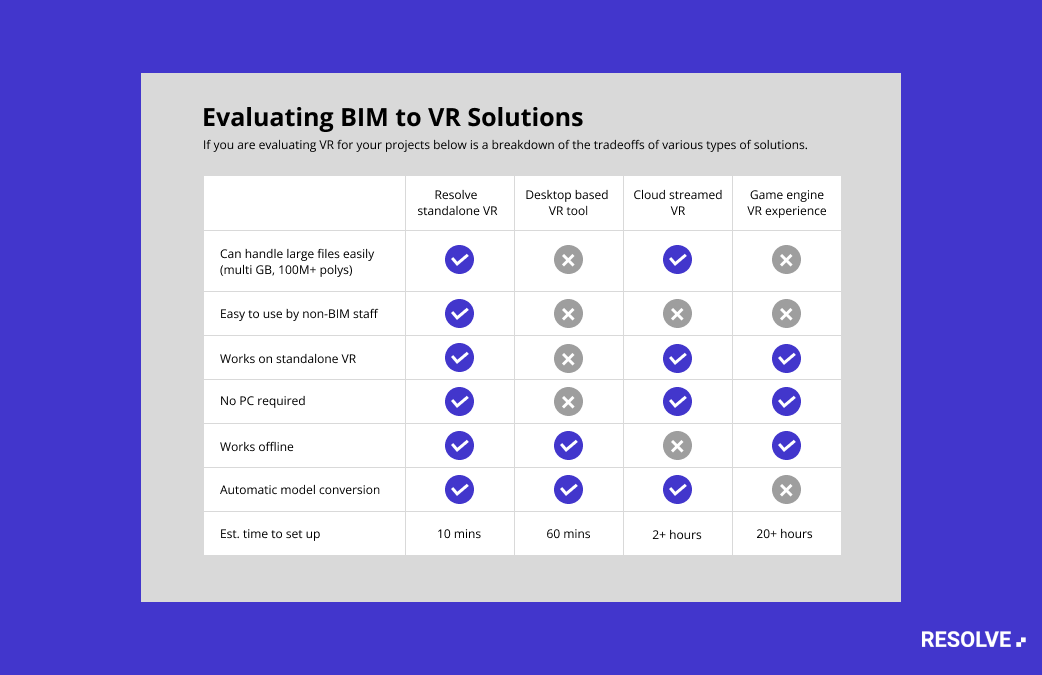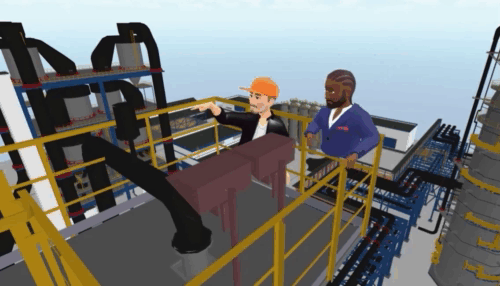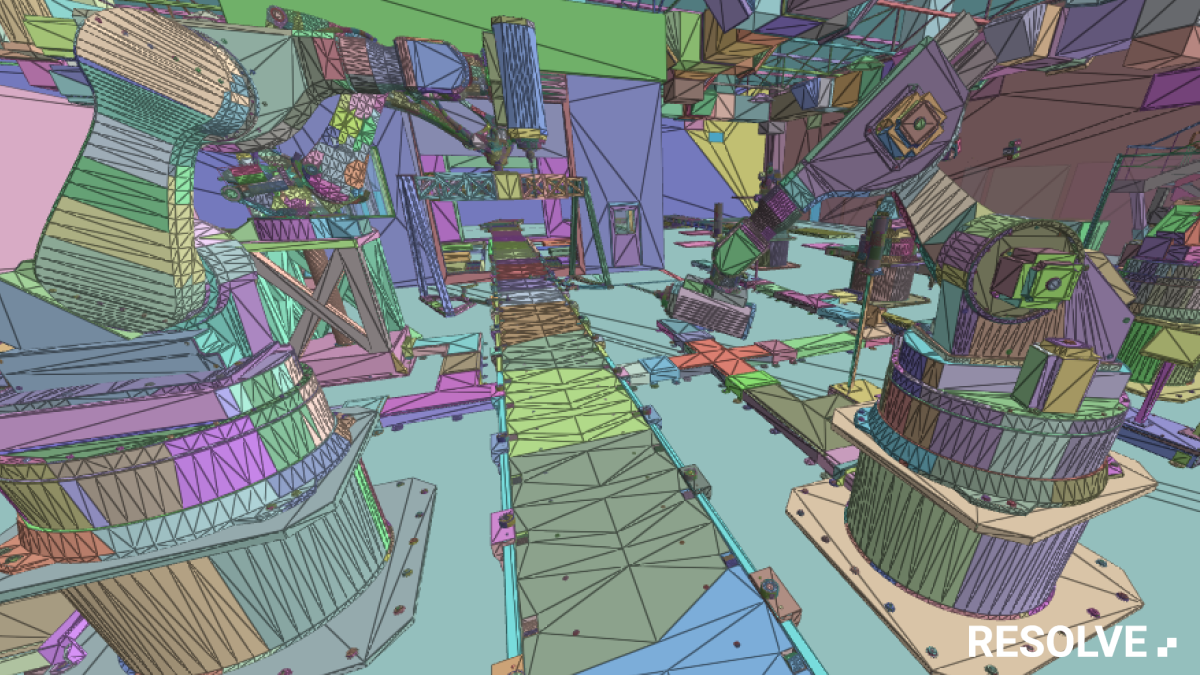How Resolve's new BIM engine delivers on the promise of VR
Resolve's new BIM engine simplifies VR for the most complex construction projects in the world. Learn how Resolve runs on wireless VR headsets.
VR’s potential for BIM reviews
It’s no secret that virtual reality (VR) provides an immersive, interactive, and more realistic representation of building models, offering unparalleled benefits over conventional 2D mediums. As our case studies show, reviewing BIM files in VR significantly improves design reviews, construction coordination, and overall project outcomes. VR helps you build it right the first time.
Yet, most companies in the design and construction industry still think twice before using VR for fear of the complex workflows and messy setups historically associated with the technology. For years, virtual reality (VR) has promised to transform how we visualize and understand construction projects before they’re built. But the increasing realism and complexity of building information models (BIM) makes it more difficult to easily leverage tools like VR without hassle.
Evaluating off the shelf BIM to VR solutions
For most needs an off the shelf VR solution makes sense. However, not all VR solutions are created equal. Reviewing fully federated BIM files in VR requires handling gigabytes of data and hundreds of millions of polygons. A thorough project review necessitates loading the entire model, not just sections, and accommodating detailed equipment geometry.

And if you really want VR to have an impact, it needs to be accessible by anyone regardless of technical skills. You need to use a wireless, standalone VR device that anyone can use, anywhere, without a PC. And that is where many existing solutions fall short.
While there are numerous VR apps with impressive features for VR reviews, most are mere wrappers around game engines like Unity or Unreal. These engines aren't optimized for large BIM. They can handle the Revit sample model just fine, but the minute you import an entire manufacturing facility with dense MEP you quickly learn how limited these out of the box offerings are for construction use cases.
Unoptimized rendering leads to a frustrating experience when you’re trying to review a complex facility and your app keeps crashing. Moreover, the time it takes for BIM teams to downsize models—reducing polygons, hiding elements, sectioning files—creates a huge hidden cost of usage.
Many solutions claim to work with devices like the Meta Quest, but they still require tethering to a PC or can only handle smaller files. The necessity for a desktop GPU limits VR accessibility to those with high-end hardware.
Some solutions opt to do cloud streaming, where they model is rendered on a GPU in the cloud and streamed to your device using a service like Azure Remote Rendering or NVIDIA Cloud XR. The limitation with these solutions is that your framerate and comfort becomes heavily tied to your network bandwidth and you can’t ever view your models offline.
Resolve’s Groundbreaking BIM Rendering for VR
Enter the Wellington Engine, Resolve's game-changing solution to viewing large BIM files in VR. Unlike other solutions, Resolve is not a simple wrapper around an existing game engine. It goes beyond, taking inspiration from powerful engines like Navisworks’ and making it work in VR.

The Wellington Engine is a two-part technology. The first part involves optimization and compression of 3D files in the cloud. The second is our runtime rendering engine written in low-level C++ and Vulkan; the rendering engine is built from the ground up to provide the smoothest VR experience regardless of BIM complexity.
When your model enters Resolve’s processing engine, we first reconstruct it into our own format that is more suitable for VR rendering. The data is intentionally packaged in a way that makes it faster to load and render your content in our runtime engine. And we don’t sacrifice functionality for performance. The process retains all the original geometry relationships so you can hide individual elements, get metadata of equipment, hide model layers, and more all on an untethered Quest headset.
And this step doesn’t take days or hours. Your project files are ready for VR in minutes with Resolve.
The Magic Behind our VR App
When you open a file on the Resolve app with your Meta Quest, the device downloads the optimized data and then renders it locally on the Quest’s Qualcomm Snapdragon chip. It does not require connecting to a computer or streaming from a cloud GPU. The magic all happens on your VR device. It bears repeating: you do not need a local or cloud PC to run Resolve.

Other BIM apps that have wireless VR support normally crash at the loading step for large files. They’re not optimized enough to load an entire data set and won’t even get as far as actually showing you something in the headset. And if your medium sized data set does make it to the rendering step they normally render at a framerate that is going to make you sick.
By contrast, the Wellington Engine is capable of opening several gigabytes worth of BIM data on your VR headset. We use cutting edge techniques in virtualized geometry to show you your model data in as much detail as possible as you virtually walk around your facility. The Wellington Engine has a custom, performance-tuned occlusion culling system, which helps determine what geometry is visible or hidden at any given time. This ensures that rendering resources are used to display detail where it is most useful.
Between every virtual step you take, Resolve’s Wellington Engine is doing highly optimized calculations and rendering to give you the most smooth experience possible. And it does it all on a $299 VR device like the Quest 2 with your largest project files.
Test Driving the Wellington Engine
Over $30B worth of construction projects around the world have now used Resolve and every day more projects are tapping into the magic of our engine. We’ve tested the Wellington Engine against data sets that are gigabytes large and have hundreds of millions of polygons. And every day new users tell us how impressed they are with Resolve’s ability to handle their most complex projects.
Some customers have even told us Resolve handles a Navisworks file better than their old VR software did with a desktop GPU!

We have a benchmark model of a manufacturing campus with dense equipment data that runs in Resolve. Just ask us for the demo campus model when you start your trial. Feel free to give it a try in Resolve and anything else you might be considering to see how well each app handles it.
VR with Results that Just Works
The advantages of Resolve’s technology are manifold. BIM and VDC managers can eliminate complex setups or time-consuming workflows to optimize 3D models for VR—Resolve handles it all. Once project files are processed for VR, anyone on the team can access the model with a wireless VR headset or on the desktop companion app, without needing a high-spec machine or relying on IT. Our solution allows teams to reap the benefits of VR without completely changing their BIM workflows. It's truly plug and play.
With the Wellington Engine, Resolve is not just pushing the boundaries of what's possible in VR BIM rendering; we're redefining them.
Do you want to upload your own BIM to review in VR? Sign up for a free trial.
Resolve builds software that makes 3D building information models more accessible so teams can find critical issues that save time and money on new construction. Resolve's Wellington Engine can render large BIM files on the standalone VR devices making it a scalable, easy to use solution for project teams. Resolve is used by leaders spanning industries like food & beverage, water treatment, data centers, biopharmaceuticals, and green energy.
